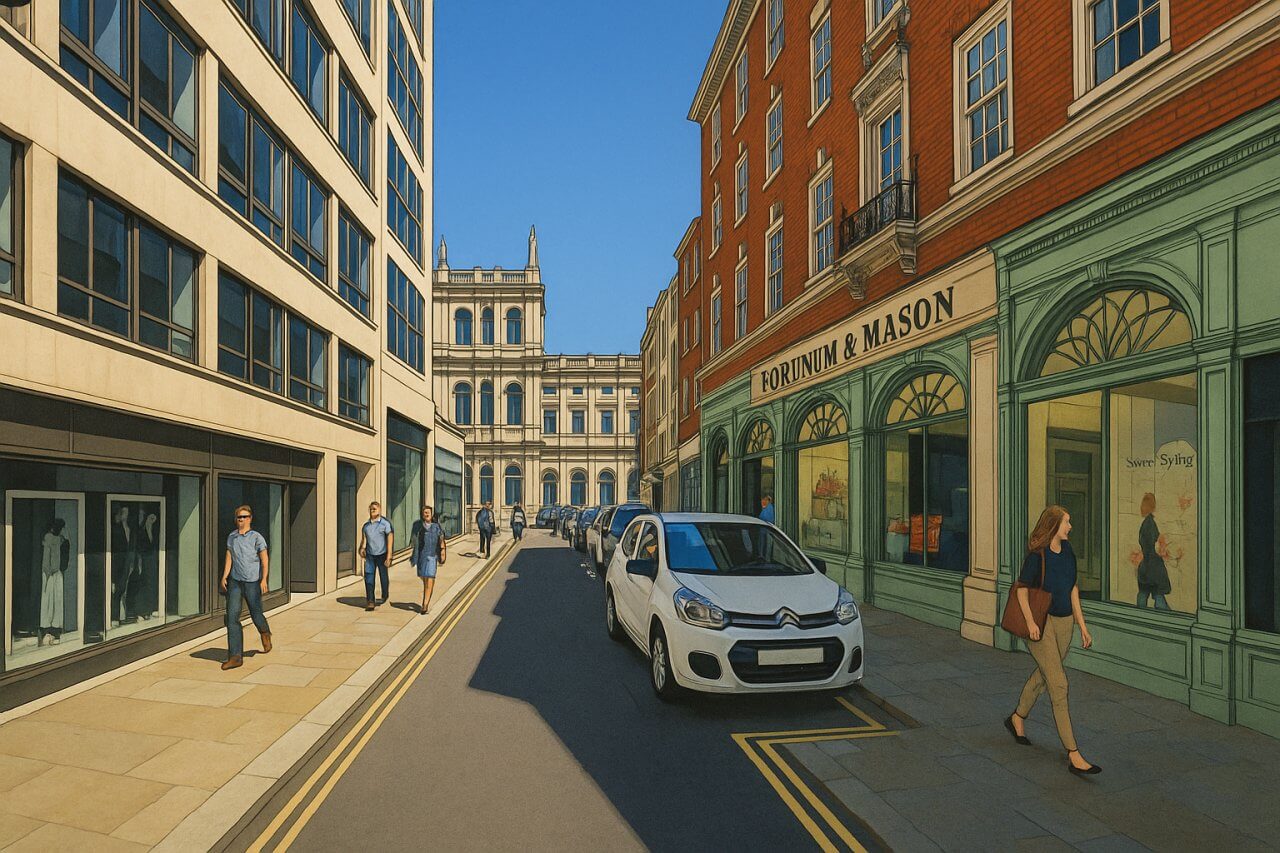
Duke Street St James's, London
Duke Street St James's is a short but significant one-way street in the heart of London's prestigious St James's district. Located within the City of Westminster, this elegant street runs north to south from Piccadilly, starting at the iconic corner of Fortnum & Mason, down to King Street, intersected midway by Jermyn Street.
Street Overview
Duke Street St James's stretches for approximately 200 metres (about 656 feet) in length. It functions as a one-way street running northbound, starting from King Street and terminating at Piccadilly. Along the way, it is joined at T-junctions by Ryder Street and Masons Yard, both of which provide discreet access to hidden cultural spaces and private institutions.
History and Origins
The origins of Duke Street St James's can be traced back to the late 17th century, when the surrounding St James’s area was being developed into a fashionable residential enclave for the aristocracy. The street took its name from James, Duke of York (later King James II), who was the brother of King Charles II and after whom the larger St James's district is also named.
The street name is pronounced as: “Duke Street Saint James’s”, phonetically rendered in the International Phonetic Alphabet as /djuːk striːt sənt ˈdʒeɪmzɪz/. The double possessive "St James’s" is characteristic of English naming conventions.
Character of the Street
Duke Street St James's is known for its refined, quiet atmosphere that reflects the traditional tone of the surrounding neighbourhood. The architecture features a mix of early 18th-century townhouses, Georgian facades, and 20th-century redevelopments. The street has long been a hub for art and antiquities, and today it remains a centre for independent art galleries, antique dealers, and discreet professional offices.
While small in size, the street is a microcosm of St James’s elegant aesthetic—polished stone pavements, restrained signage, and a notable absence of mass-market retail outlets contribute to its understated charm.
Places of Interest and Cultural Highlights
- Fortnum & Mason: Although located on Piccadilly, this world-famous luxury department store sits at the corner of Duke Street St James's and is synonymous with the street's northern gateway.
- Mason's Yard: Accessible via a T-junction, this secluded courtyard is home to the White Cube Gallery and other boutique art spaces.
- The Sladmore Gallery and Sims Reed Gallery: Notable establishments that represent the area’s deep association with fine arts.
- St James’s Market: Just to the east, offering a vibrant mix of dining and cultural spaces with a contemporary twist on traditional London heritage.
Property and Real Estate
Duke Street St James's features some of the most exclusive commercial and residential properties in central London. Residential flats and townhouses in the area typically command premium prices. As of early 2025, residential property prices along the street range from approximately £3,000 to £4,500 per square foot (approx. £32,300 to £48,400 per sq metre), reflecting the prestige and historic significance of the area.
A refurbished two-bedroom flat of around 1,200 square feet (approx. 111.5 sq metres) may be priced upwards of £4.5 million, while larger properties and freeholds command even higher sums. Commercial spaces, particularly those suitable for galleries or luxury offices, are also highly sought after in this prime West End location.
Transport Links
Nearest Underground Stations
- Green Park Station (served by the Jubilee, Piccadilly, and Victoria lines): Approximately a 5-minute walk west via Piccadilly.
- Piccadilly Circus Station (served by the Bakerloo and Piccadilly lines): Around 7 minutes' walk to the northeast.
- Charing Cross Station (serving both rail and the Bakerloo and Northern lines): Within 10–12 minutes’ walk east.
Nearby Bus Routes
The nearest bus stops are on Piccadilly, just a few metres from the junction with Duke Street St James's. Key routes include:
- Bus 9: Hammersmith to Aldwych
- Bus 14: Putney Heath to Russell Square
- Bus 19: Battersea Bridge to Finsbury Park
- Bus 38: Victoria to Clapton Pond
Fun Fact
While small and easily overlooked, Duke Street St James's has quietly maintained its role as one of the most prestigious addresses in the West End art scene. It’s also one of the few streets in central London that retains multiple independent, long-established galleries—some of which have operated for over a century.
Moreover, during the 18th and 19th centuries, the street and its environs were known to host several private gentlemen’s clubs, a few of which persist nearby today, lending the area its reputation for exclusivity and privacy.
Quick Facts
- Location: St James's, City of Westminster, London
- Length: Approx. 200 metres (656 feet)
- Traffic Direction: One-way northbound
- Connected Roads: Piccadilly (north), King Street (south), Jermyn Street (crosses), Ryder Street and Mason’s Yard (T-junctions)
- Nearest Tube Stations: Green Park, Piccadilly Circus, Charing Cross
- Nearby Bus Stops: Located on Piccadilly
- Pronunciation: "Duke Street Saint James’s" (/djuːk striːt sənt ˈdʒeɪmzɪz/)
- Main Attractions: Fortnum & Mason, White Cube Gallery, independent art dealers
- Real Estate: £3,000–£4,500 per sq ft (£32,300–£48,400 per sq m) as of early 2025
- Historic Significance: Named after James, Duke of York (later James II)
- Character: Elegant, discreet, artistic, and steeped in tradition
Map of Duke Street St James's, London
Streets connected to Duke Street St James's

Painting of Duke Street St James's, London (View image in full size)